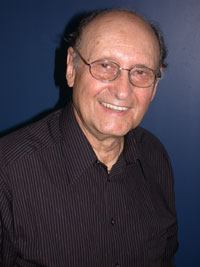
For Release: August 22, 2011
131st AES Convention Historical Events: Stokowski to Sear
+ The History Of Recording – From 1 Mic To 24 Tracks & Audio Archiving
NEW YORK: “The goal of the AES Convention Historical Program is to revisit the accomplishments of pro audio past masters within a context which makes them relevant to next-generation audio practitioners,” states 131st AES Convention Chair Jim Anderson. “This year, longtime Historical Events Chair Harry Hirsch has nurtured four events which fully serve that objective.” Scheduled for Oct. 20 thru 23 in NY’s Jacob Javits Convention Center, this year’s convention is expected to attract over 20,000 attendees from around the world.
131st AES CONVENTION HISTORICAL EVENTS:
LEOPOLD STOKOWSKI AND THE HISTORY OF ANALOG RECORDING: Presented by Robert Auld - A prolific recording artist from 1917 until 1977 - virtually the entire period of analog music recording - Stokowski’s passion for the art and technology of recording inspired a constant dialogue with engineers and researchers developing new techniques and technology. This remarkable 60-year time line illustrates major developments in analog recording from the perspective of a single (and singular) artist. Mr. Auld's presentation features rare recordings, still photos and film clips drawn from Stokowski’s extensive archives. Highlights include his pioneering work with multi-channel sound recording; his invaluable collaboration with Bell Labs starting in 1932; his work with Walt Disney for the film Fantasia; and his encouragement of quadraphonic sound recording in the 1970's. A former Chairman of the AES New York Section, Robert Auld is a highly respected NYC-based audio engineer. His clients include National Public Radio, the BBC, and the Riverside Symphony. He has written for Recording Magazine, and frequently lectures on historical audio subjects at AES conventions and section meetings.
A TRIBUTE TO WALTER SEAR: Presenter, Noah Simon - Since his death in April 2010, Walter Sear’s world-famous Sear Sound recording studio has continued to thrive as a champion of analog fidelity. With its reputation for meticulously selected and maintained equipment and a superbly trained staff, Sear Sound has attracted such clients as Paul McCartney, Wilco and Norah Jones. Walter Sear's encyclopedic knowledge of and unbridled passion for audio quality set a Platinum standard for studios around the world. This panel will address Sear’s incomparable life and legendary accomplishments from audio engineering and music composition, to his experimentation with theremins and synthesizers. Noah Simon is a Brooklyn-based engineer/producer/arranger and long-time AES member. He has worked with artists such as Eric Anderson, Scout, Bill Frisell, Susan Tedeschi and Shawn Colvin.
CLASSICAL RECORDING IN AMERICA – FROM ONE MICROPHONE TO 24 TRACKS: Presented by Thomas Fine. An exploration of the history of recording techniques and equipment from the 1954 heyday of monophonic full-range high fidelity. Beginning with a single mic, evolving to early stereo’s "golden age of recording" and the increasing complexity of the late 1960's and early ‘70's, when Columbia and EMI won Grammys for classical recordings made with as many as 32 mics and 24 tracks. Highlighted by a rare, comparative listening session featuring Grammy-winning recordings of Ravel's Daphnis et Chloe recorded over three decades. Thomas Fine is a member of ARSC and owner of an analog-to-digital audio transfer studio. With a primary base of archival and education/ institutional clients, Mr. Fine specializes in transferring magnetic and grooved-disc media to high resolution digital formats. He is an avid collector of music recordings and student of recording-industry history.
AUDIO ARCHIVING AND PRESERVATION 101 – TWO IMPORTANT BROADCAST COLLECTIONS: Presenter - James Sam, Hoover Institution Archives, Stanford University. The audio preservation program at the Hoover Institution Archives of Stanford University is a real-world implementation of archival best practices. Two large collections of the Archives are the Radio Free Europe/Radio Liberty and the Commonwealth Club of California collections. These are eerily similar in their recording formats and time spans. Despite being generated on two different continents, their archival approach remains the same. Mr. Sam will discuss this approach and its implications for both legacy and new recordings. He will also describe preservation methods used, employing fascinating examples from the collections. From 2003 to 2006, James Sam was a sound preservation engineer at the Cutting Corporation in Bethesda, MD. In 2006, he joined the Hoover Institution Archives, Stanford University. He is a member of the Audio Engineering Society.
“Just before he attacked The Alamo, George Santayana said ‘those who do not study the past are doomed to repeat it,’” Harry Hirsch remarked. “In the case of pro audio history, however, our events are clearly inspirational and instructive. Today’s audio pros have a deep and abiding respect for the accomplishments of our predecessors. And by the way,” he adds, “it was really George’s brother, General Antonio Lopez de Santa Anna who attacked the Alamo.” An indomitable veteran of fifty+ years in the trenches of professional audio, AES Historical Committee Chair Harry Hirsch is a former drummer, recording studio owner/builder/designer and expert CD DVD editor/duplicator. He has edited and transferred over 100 DVD interviews for the ongoing AES Oral History Project.
Photo: 131st AES Convention Historical Events Chair, Harry Hirsch
###
The Audio Engineering Society was formed in 1948 by a group of concerned audio engineers. The AES counts over 14,000 members throughout the U.S., Latin America, Europe, Japan and the Far East. The organization serves as the pivotal force in the exchange and dissemination of technical information for the industry. For additional information visit http://www.aes.org



